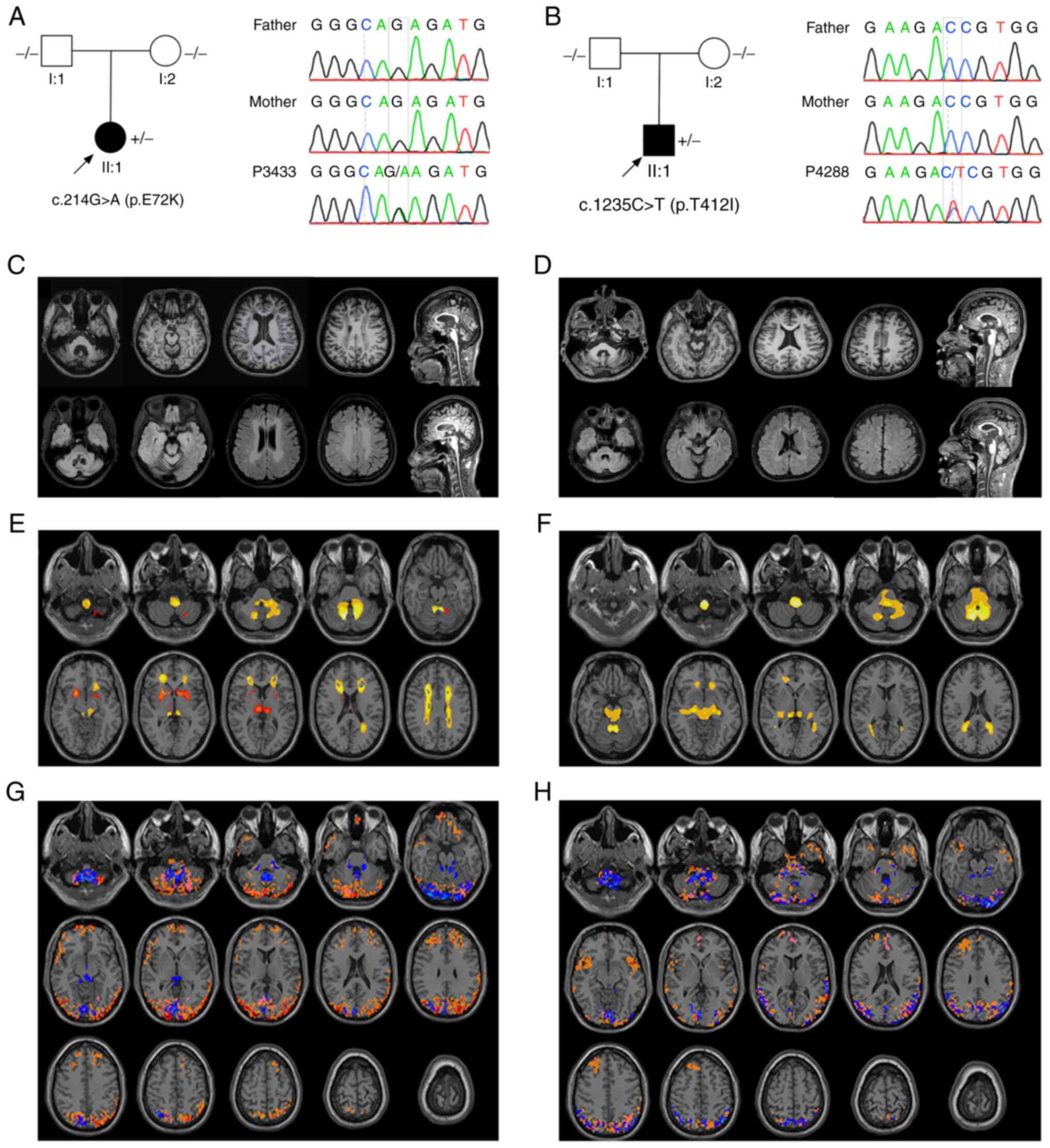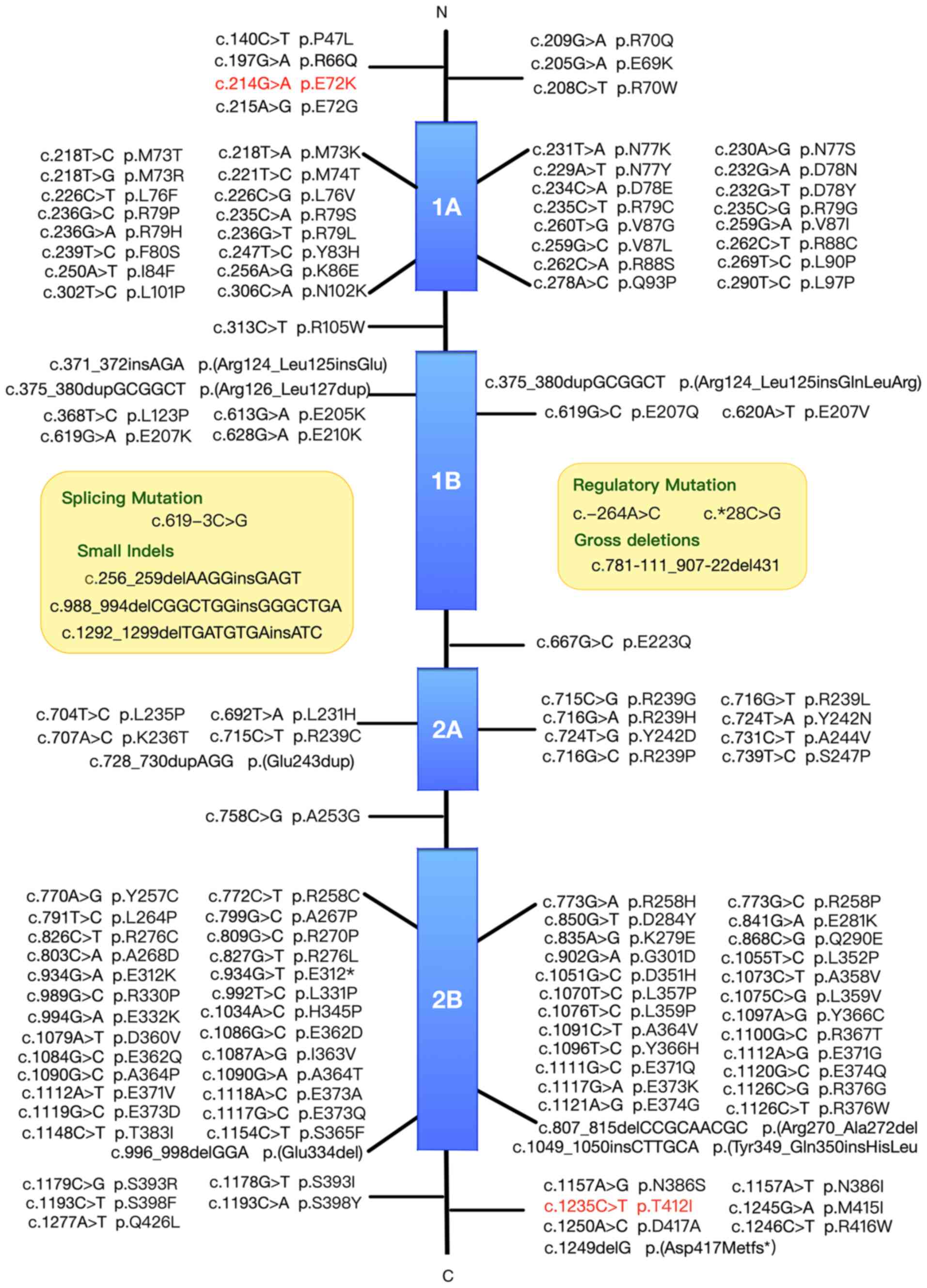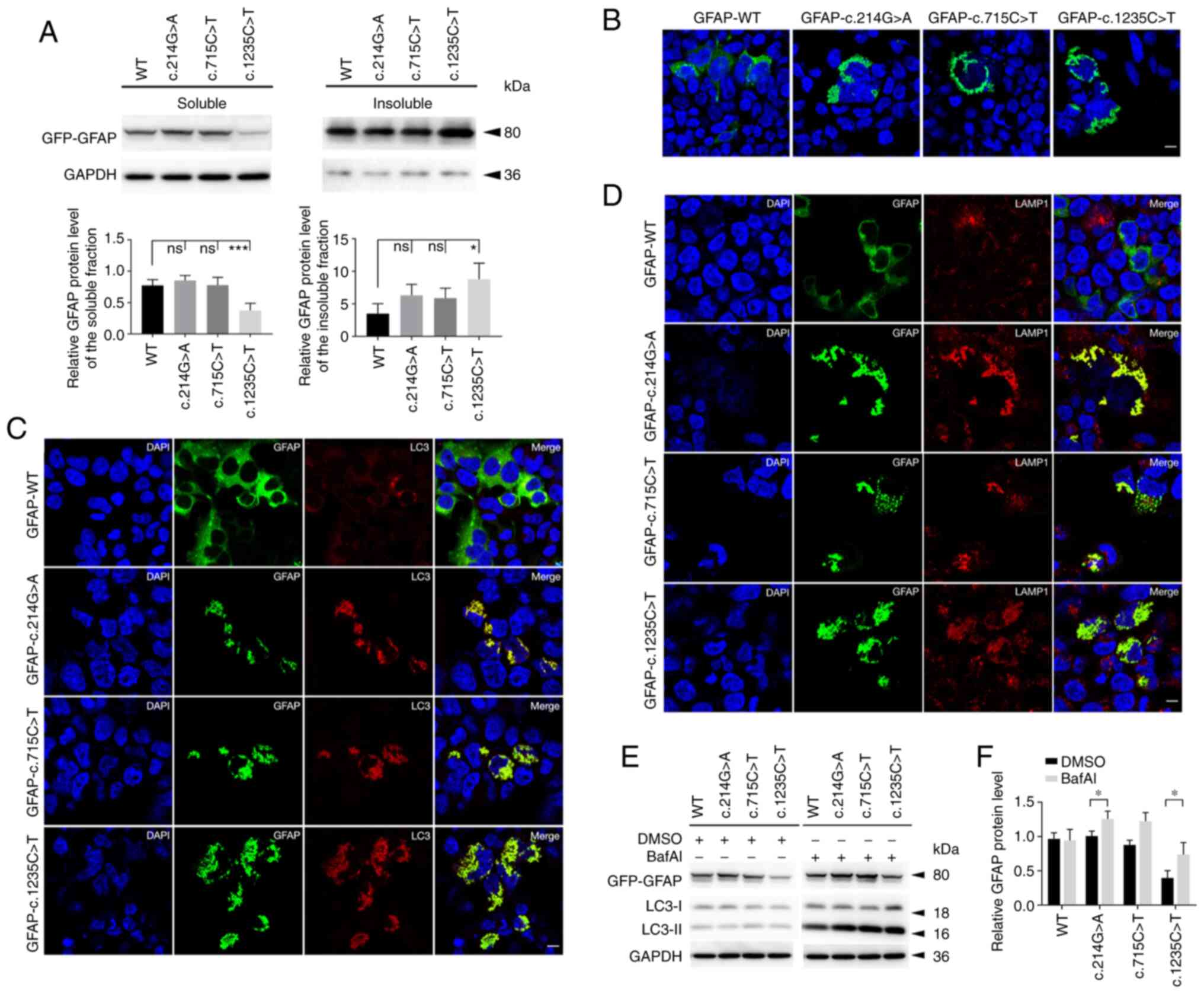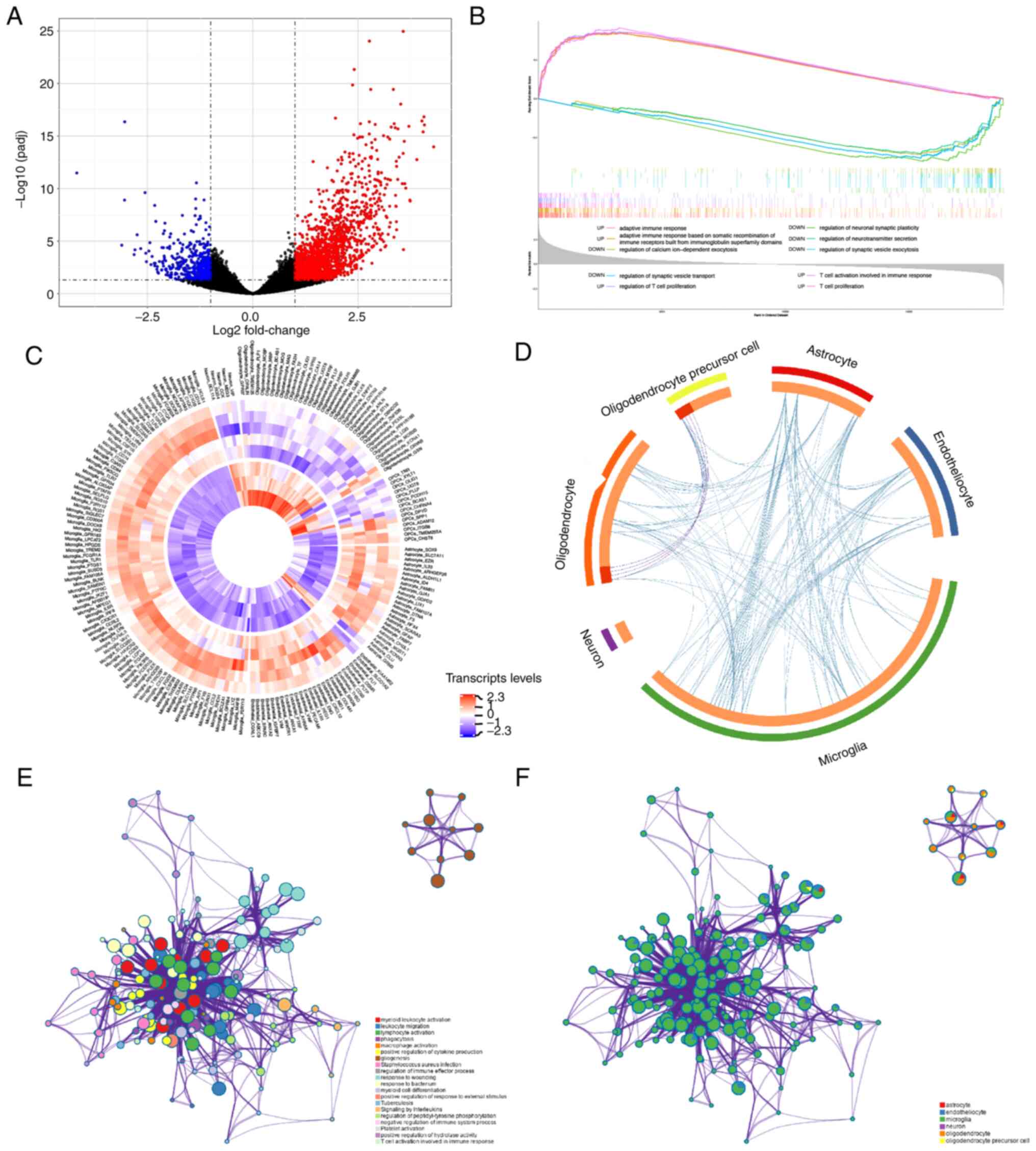|
1
|
Messing A: Alexander disease. Handb Clin
Neurol. 148:693–700. 2018. View Article : Google Scholar : PubMed/NCBI
|
|
2
|
Iwaki T, Kume-Iwaki A, Liem RK and Goldman
JE: α B-crystallin is expressed in non-lenticular tissues and
accumulates in Alexander's disease brain. Cell. 57:71–78. 1989.
View Article : Google Scholar : PubMed/NCBI
|
|
3
|
Brenner M, Johnson AB, Boespflug-Tanguy O,
Rodriguez D, Goldman JE and Messing A: Mutations in GFAP, encoding
glial fibrillary acidic protein, are associated with Alexander
disease. Nat Genet. 27:117–120. 2001. View
Article : Google Scholar : PubMed/NCBI
|
|
4
|
Hol EM and Capetanaki Y: Type III
Intermediate Filaments Desmin, Glial Fibrillary Acidic Protein
(GFAP), Vimentin, and Peripherin. Cold Spring Harb Perspect Biol.
9:a0216422017. View Article : Google Scholar : PubMed/NCBI
|
|
5
|
Li R, Messing A, Goldman JE and Brenner M:
GFAP mutations in Alexander disease. Int J Dev Neurosci.
20:259–268. 2002. View Article : Google Scholar : PubMed/NCBI
|
|
6
|
Quinlan RA, Brenner M, Goldman JE and
Messing A: GFAP and its role in Alexander disease. Exp Cell Res.
313:2077–2087. 2007. View Article : Google Scholar : PubMed/NCBI
|
|
7
|
Jones JR, Kong L, Hanna MG IV, Hoffman B,
Krencik R, Bradley R, Hagemann T, Choi J, Doers M, Dubovis M, et
al: Mutations in GFAP Disrupt the Distribution and Function of
Organelles in Human Astrocytes. Cell Rep. 25:947–958.e4. 2018.
View Article : Google Scholar : PubMed/NCBI
|
|
8
|
Li R, Johnson AB, Salomons G, Goldman JE,
Naidu S, Quinlan R, Cree B, Ruyle SZ, Banwell B, D'Hooghe M, et al:
Glial fibrillary acidic protein mutations in infantile, juvenile,
and adult forms of Alexander disease. Ann Neurol. 57:310–326. 2005.
View Article : Google Scholar : PubMed/NCBI
|
|
9
|
Yoshida T, Sasaki M, Yoshida M, Namekawa
M, Okamoto Y, Tsujino S, Sasayama H, Mizuta I and Nakagawa M;
Alexander Disease Study Group in Japan, : Nationwide survey of
Alexander disease in Japan and proposed new guidelines for
diagnosis. J Neurol. 258:1998–2008. 2011. View Article : Google Scholar : PubMed/NCBI
|
|
10
|
Johnson AB and Brenner M: Alexander's
disease: Clinical, pathologic, and genetic features. J Child
Neurol. 18:625–632. 2003. View Article : Google Scholar : PubMed/NCBI
|
|
11
|
Miller SA, Dykes DD and Polesky HF; MWer
S, : A simple salting out procedure for extracting DNA from human
nucleated cells. Nucleic Acids Res. 16:12151988. View Article : Google Scholar : PubMed/NCBI
|
|
12
|
Li H and Durbin R: Fast and accurate short
read alignment with Burrows-Wheeler transform. Bioinformatics.
25:1754–1760. 2009. View Article : Google Scholar : PubMed/NCBI
|
|
13
|
McKenna A, Hanna M, Banks E, Sivachenko A,
Cibulskis K, Kernytsky A, Garimella K, Altshuler D, Gabriel S, Daly
M, et al: The Genome Analysis Toolkit: A MapReduce framework for
analyzing next-generation DNA sequencing data. Genome Res.
20:1297–1303. 2010. View Article : Google Scholar : PubMed/NCBI
|
|
14
|
Wang K, Li M and Hakonarson H: ANNOVAR:
Functional annotation of genetic variants from high-throughput
sequencing data. Nucleic Acids Res. 38:e164. 2010. View Article : Google Scholar : PubMed/NCBI
|
|
15
|
Richards S, Aziz N, Bale S, Bick D, Das S,
Gastier-Foster J, Grody WW, Hegde M, Lyon E, Spector E, et al ACMG
Laboratory Quality Assurance Committee, : Standards and guidelines
for the interpretation of sequence variants: A joint consensus
recommendation of the American College of Medical Genetics and
Genomics and the Association for Molecular Pathology. Genet Med.
17:405–424. 2015. View Article : Google Scholar : PubMed/NCBI
|
|
16
|
Yan CG, Wang XD, Zuo XN and Zang YF:
DPABI: Data Processing & Analysis for (Resting-State) Brain
Imaging. Neuroinformatics. 14:339–351. 2016. View Article : Google Scholar : PubMed/NCBI
|
|
17
|
Yang H, Long XY, Yang Y, Yan H, Zhu CZ,
Zhou XP, Zang YF and Gong QY: Amplitude of low frequency
fluctuation within visual areas revealed by resting-state
functional MRI. Neuroimage. 36:144–152. 2007. View Article : Google Scholar : PubMed/NCBI
|
|
18
|
Eijlers AJ, Meijer KA, Wassenaar TM,
Steenwijk MD, Uitdehaag BM, Barkhof F, Wink AM, Geurts JJ and
Schoonheim MM: Increased default-mode network centrality in
cognitively impaired multiple sclerosis patients. Neurology.
88:952–960. 2017. View Article : Google Scholar : PubMed/NCBI
|
|
19
|
Zang Y, Jiang T, Lu Y, He Y and Tian L:
Regional homogeneity approach to fMRI data analysis. Neuroimage.
22:394–400. 2004. View Article : Google Scholar : PubMed/NCBI
|
|
20
|
Bresciani A, Spiezia MC, Boggio R, Cariulo
C, Nordheim A, Altobelli R, Kuhlbrodt K, Dominguez C, Munoz-Sanjuan
I, Wityak J, et al: Quantifying autophagy using novel LC3B and p62
TR-FRET assays. PLoS One. 13:e01944232018. View Article : Google Scholar : PubMed/NCBI
|
|
21
|
Li L, Tian E, Chen X, Chao J, Klein J, Qu
Q, Sun G, Sun G, Huang Y, Warden CD, et al: GFAP Mutations in
Astrocytes Impair Oligodendrocyte Progenitor Proliferation and
Myelination in an hiPSC Model of Alexander Disease. Cell Stem Cell.
23:239–251.e6. 2018. View Article : Google Scholar : PubMed/NCBI
|
|
22
|
Love MI, Huber W and Anders S: Moderated
estimation of fold change and dispersion for RNA-seq data with
DESeq2. Genome Biol. 15:5502014. View Article : Google Scholar : PubMed/NCBI
|
|
23
|
Wickham H: ggplot2. Wiley Interdiscip Rev
Comput Stat. 3:180–185. 2011. View Article : Google Scholar
|
|
24
|
Subramanian A, Tamayo P, Mootha VK,
Mukherjee S, Ebert BL, Gillette MA, Paulovich A, Pomeroy SL, Golub
TR, Lander ES, et al: Gene set enrichment analysis: A
knowledge-based approach for interpreting genome-wide expression
profiles. Proc Natl Acad Sci USA. 102:15545–15550. 2005. View Article : Google Scholar : PubMed/NCBI
|
|
25
|
Yu G, Wang L-G, Han Y and He Q-Y:
clusterProfiler: An R package for comparing biological themes among
gene clusters. OMICS. 16:284–287. 2012. View Article : Google Scholar : PubMed/NCBI
|
|
26
|
Ashburner M, Ball CA, Blake JA, Botstein
D, Butler H, Cherry JM, Davis AP, Dolinski K, Dwight SS, Eppig JT,
et al The Gene Ontology Consortium, : Gene ontology: Tool for the
unification of biology. Nat Genet. 25:25–29. 2000. View Article : Google Scholar : PubMed/NCBI
|
|
27
|
McKenzie AT, Wang M, Hauberg ME, Fullard
JF, Kozlenkov A, Keenan A, Hurd YL, Dracheva S, Casaccia P, Roussos
P, et al: Brain cell type specific gene expression and
co-expression network architectures. Sci Rep. 8:1–19. 2018.
View Article : Google Scholar
|
|
28
|
Gu Z, Gu L, Eils R, Schlesner M and Brors
B: circlize Implements and enhances circular visualization in R.
Bioinformatics. 30:2811–2812. 2014. View Article : Google Scholar : PubMed/NCBI
|
|
29
|
Zhou Y, Zhou B, Pache L, Chang M,
Khodabakhshi AH, Tanaseichuk O, Benner C and Chanda SK: Metascape
provides a biologist-oriented resource for the analysis of
systems-level datasets. Nat Commun. 10:1–10. 2019.
|
|
30
|
Prust M, Wang J, Morizono H, Messing A,
Brenner M, Gordon E, Hartka T, Sokohl A, Schiffmann R,
Gordish-Dressman H, et al: GFAP mutations, age at onset, and
clinical subtypes in Alexander disease. Neurology. 77:1287–1294.
2011. View Article : Google Scholar : PubMed/NCBI
|
|
31
|
Olabarria M and Goldman JE: Disorders of
Astrocytes: Alexander Disease as a Model. Annu Rev Pathol.
12:131–152. 2017. View Article : Google Scholar : PubMed/NCBI
|
|
32
|
Yoshida T: Clinical characteristics of
Alexander disease. Neurodegener Dis Manag. 10:325–333. 2020.
View Article : Google Scholar : PubMed/NCBI
|
|
33
|
Messing A and Brenner M: GFAP at 50. ASN
Neuro. 12:17590914209496802020. View Article : Google Scholar : PubMed/NCBI
|
|
34
|
Stumpf E, Masson H, Duquette A, Berthelet
F, McNabb J, Lortie A, Lesage J, Montplaisir J, Brais B and
Cossette P: Adult Alexander disease with autosomal dominant
transmission: A distinct entity caused by mutation in the glial
fibrillary acid protein gene. Arch Neurol. 60:1307–1312. 2003.
View Article : Google Scholar : PubMed/NCBI
|
|
35
|
Messing A, Brenner M, Feany MB, Nedergaard
M and Goldman JE: Alexander disease. J Neurosci. 32:5017–5023.
2012. View Article : Google Scholar : PubMed/NCBI
|
|
36
|
Kinoshita T, Imaizumi T, Miura Y, Fujimoto
H, Ayabe M, Shoji H, Okamoto Y, Takashima H, Osame M and Nakagawa
M: A case of adult-onset Alexander disease with Arg416Trp human
glial fibrillary acidic protein gene mutation. Neurosci Lett.
350:169–172. 2003. View Article : Google Scholar : PubMed/NCBI
|
|
37
|
Sawaishi Y: Review of Alexander disease:
Beyond the classical concept of leukodystrophy. Brain Dev.
31:493–498. 2009. View Article : Google Scholar : PubMed/NCBI
|
|
38
|
Balbi P, Salvini S, Fundarò C, Frazzitta
G, Maestri R, Mosah D, Uggetti C and Sechi G: The clinical spectrum
of late-onset Alexander disease: A systematic literature review. J
Neurol. 257:1955–1962. 2010. View Article : Google Scholar : PubMed/NCBI
|
|
39
|
van der Knaap MS, Ramesh V, Schiffmann R,
Blaser S, Kyllerman M, Gholkar A, Ellison DW, van der Voorn JP, van
Dooren SJ, Jakobs C, et al: Alexander disease: Ventricular garlands
and abnormalities of the medulla and spinal cord. Neurology.
66:494–498. 2006. View Article : Google Scholar : PubMed/NCBI
|
|
40
|
Eshaghi A, Prados F, Brownlee WJ, Altmann
DR, Tur C, Cardoso MJ, De Angelis F, van de Pavert SH, Cawley N, De
Stefano N, et al MAGNIMS study group, : Deep gray matter volume
loss drives disability worsening in multiple sclerosis. Ann Neurol.
83:210–222. 2018. View Article : Google Scholar : PubMed/NCBI
|
|
41
|
Roosendaal SD, Bendfeldt K, Vrenken H,
Polman CH, Borgwardt S, Radue EW, Kappos L, Pelletier D, Hauser SL,
Matthews PM, et al: Grey matter volume in a large cohort of MS
patients: Relation to MRI parameters and disability. Mult Scler.
17:1098–1106. 2011. View Article : Google Scholar : PubMed/NCBI
|
|
42
|
Eshaghi A, Marinescu RV, Young AL, Firth
NC, Prados F, Jorge Cardoso M, Tur C, De Angelis F, Cawley N,
Brownlee WJ, et al: Progression of regional grey matter atrophy in
multiple sclerosis. Brain. 141:1665–1677. 2018. View Article : Google Scholar : PubMed/NCBI
|
|
43
|
Calabrese M, Magliozzi R, Ciccarelli O,
Geurts JJ, Reynolds R and Martin R: Exploring the origins of grey
matter damage in multiple sclerosis. Nat Rev Neurosci. 16:147–158.
2015. View Article : Google Scholar : PubMed/NCBI
|
|
44
|
Ramnani N: Frontal lobe and posterior
parietal contributions to the cortico-cerebellar system.
Cerebellum. 11:366–383. 2012. View Article : Google Scholar : PubMed/NCBI
|
|
45
|
Chen YS, Lim SC, Chen MH, Quinlan RA and
Perng MD: Alexander disease causing mutations in the C-terminal
domain of GFAP are deleterious both to assembly and network
formation with the potential to both activate caspase 3 and
decrease cell viability. Exp Cell Res. 317:2252–2266. 2011.
View Article : Google Scholar : PubMed/NCBI
|
|
46
|
Der Perng M, Su M, Wen SF, Li R, Gibbon T,
Prescott AR, Brenner M and Quinlan RA: The Alexander
disease-causing glial fibrillary acidic protein mutant, R416W,
accumulates into Rosenthal fibers by a pathway that involves
filament aggregation and the association of alpha B-crystallin and
HSP27. Am J Hum Genet. 79:197–213. 2006. View Article : Google Scholar : PubMed/NCBI
|
|
47
|
Yoshida T, Sasayama H and Nakagawa M: The
process of inducing GFAP aggregates in astrocytoma-derived cells is
different between R239C and R416W mutant GFAP. A time-lapse
recording study. Neurosci Lett. 458:11–14. 2009. View Article : Google Scholar : PubMed/NCBI
|
|
48
|
Hsiao VC, Tian R, Long H, Der Perng M,
Brenner M, Quinlan RA and Goldman JE: Alexander-disease mutation of
GFAP causes filament disorganization and decreased solubility of
GFAP. J Cell Sci. 118:2057–2065. 2005. View Article : Google Scholar : PubMed/NCBI
|
|
49
|
Kwon YT and Ciechanover A: The Ubiquitin
Code in the Ubiquitin-Proteasome System and Autophagy. Trends
Biochem Sci. 42:873–886. 2017. View Article : Google Scholar : PubMed/NCBI
|
|
50
|
Tang G, Xu Z and Goldman JE: Synergistic
effects of the SAPK/JNK and the proteasome pathway on glial
fibrillary acidic protein (GFAP) accumulation in Alexander disease.
J Biol Chem. 281:38634–38643. 2006. View Article : Google Scholar : PubMed/NCBI
|
|
51
|
Tang G, Perng MD, Wilk S, Quinlan R and
Goldman JE: Oligomers of mutant glial fibrillary acidic protein
(GFAP) Inhibit the proteasome system in alexander disease
astrocytes, and the small heat shock protein alphaB-crystallin
reverses the inhibition. J Biol Chem. 285:10527–10537. 2010.
View Article : Google Scholar : PubMed/NCBI
|
|
52
|
Tang G, Yue Z, Talloczy Z, Hagemann T, Cho
W, Messing A, Sulzer DL and Goldman JE: Autophagy induced by
Alexander disease-mutant GFAP accumulation is regulated by p38/MAPK
and mTOR signaling pathways. Hum Mol Genet. 17:1540–1555. 2008.
View Article : Google Scholar : PubMed/NCBI
|
|
53
|
Singhal G, Jaehne EJ, Corrigan F, Toben C
and Baune BT: Inflammasomes in neuroinflammation and changes in
brain function: A focused review. Front Neurosci. 8:3152014.
View Article : Google Scholar : PubMed/NCBI
|
|
54
|
Olabarria M, Putilina M, Riemer EC and
Goldman JE: Astrocyte pathology in Alexander disease causes a
marked inflammatory environment. Acta Neuropathol. 130:469–486.
2015. View Article : Google Scholar : PubMed/NCBI
|
|
55
|
Kora K, Kato T, Ide M, Tanaka T and
Yoshida T: Inflammatory neuropathology of infantile Alexander
disease: A case report. Brain Dev. 42:64–68. 2020. View Article : Google Scholar : PubMed/NCBI
|
|
56
|
Hagemann TL, Connor JX and Messing A:
Alexander disease-associated glial fibrillary acidic protein
mutations in mice induce Rosenthal fiber formation and a white
matter stress response. J Neurosci. 26:11162–11173. 2006.
View Article : Google Scholar : PubMed/NCBI
|
|
57
|
Minkel HR, Anwer TZ, Arps KM, Brenner M
and Olsen ML: Elevated GFAP induces astrocyte dysfunction in caudal
brain regions: A potential mechanism for hindbrain involved
symptoms in type II Alexander disease. Glia. 63:2285–2297. 2015.
View Article : Google Scholar : PubMed/NCBI
|
|
58
|
Hagemann TL, Gaeta SA, Smith MA, Johnson
DA, Johnson JA and Messing A: Gene expression analysis in mice with
elevated glial fibrillary acidic protein and Rosenthal fibers
reveals a stress response followed by glial activation and neuronal
dysfunction. Hum Mol Genet. 14:2443–2458. 2005. View Article : Google Scholar : PubMed/NCBI
|


















